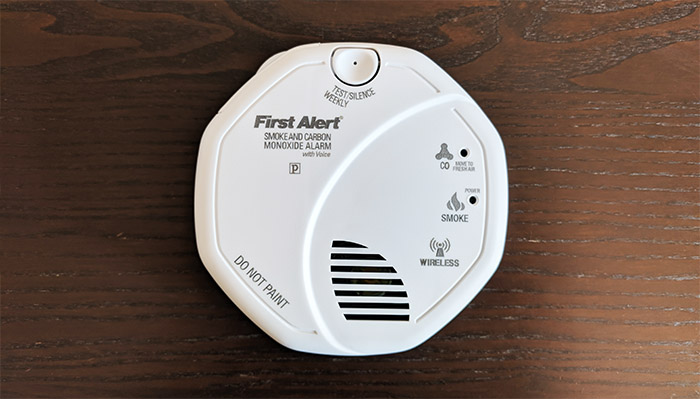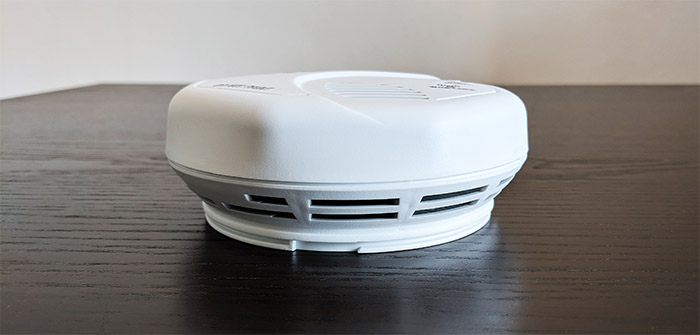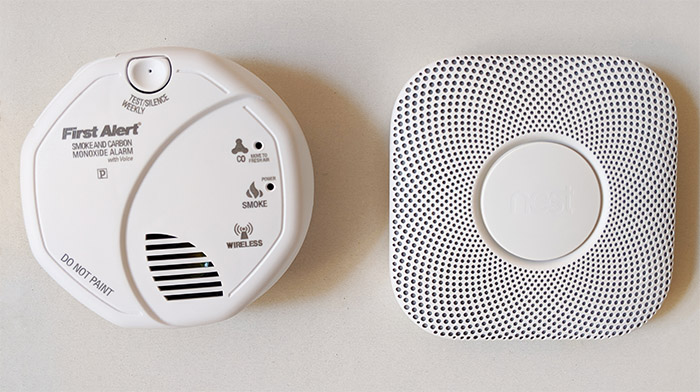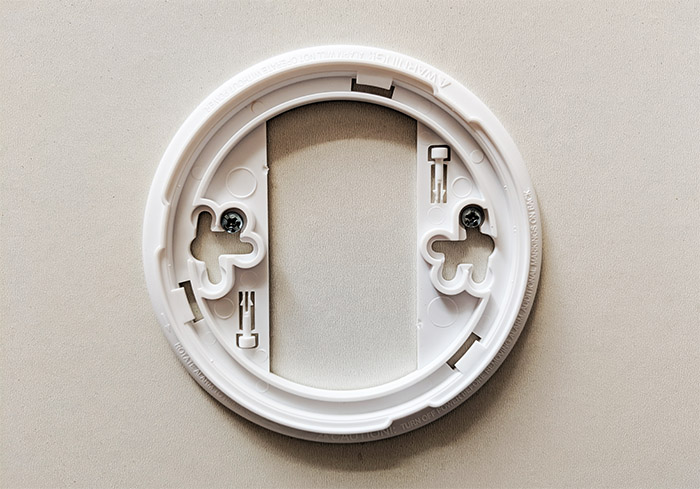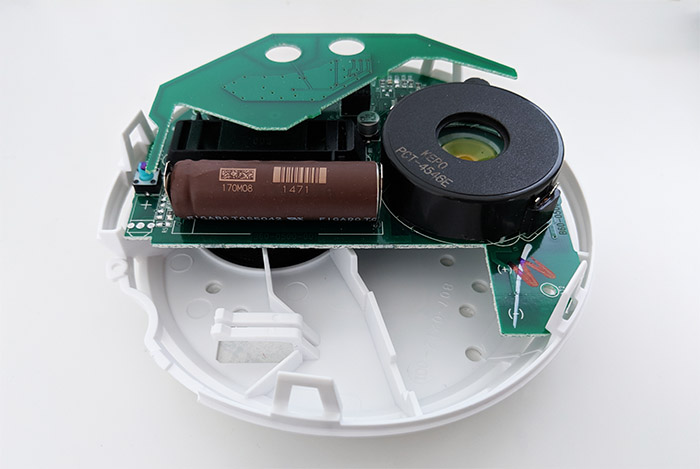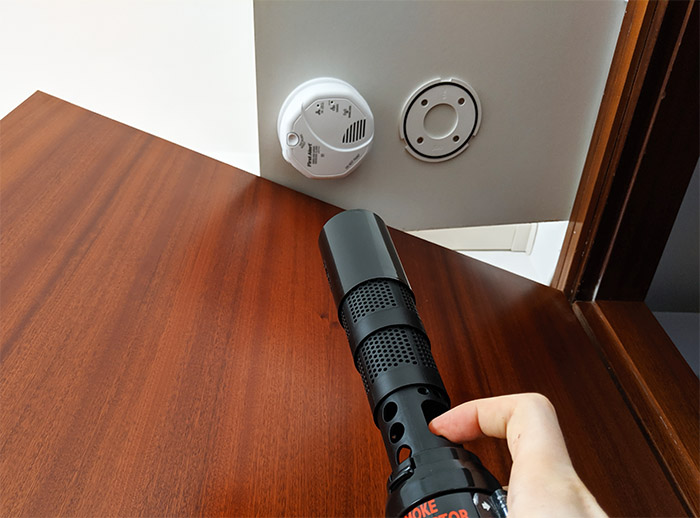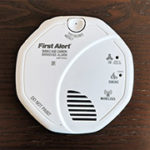The First Alert SCO501CN-3ST is an UL-certified traditional smoke and CO detector built to ensure the safety of your home relying on a photoelectric sensor to detect smoke, an electrochemical sensor for detecting rising levels of Carbon Monoxide and a loud voice alarm to make sure you wake up in case of an emergency (conforms to UL STD 217 and UL STD 2034). While it lacks the bells and whistles of a smart smoke detector (such as the Nest Protect), the First Alert SCO501CN-3ST can interconnect with up to 15 other detectors via wireless (16 devices in total) and the system can easily be programmed to shout the location of the room where smoke/CO has been detected.
| First Alert SCO501CN-3ST | |
|---|---|
| Amazon.com | Check Offer |
It’s true that the market is slowly pushing the customer towards adopting smarter devices which can be connected to the WiFi network, but considering that the smoke alarm can make a difference between life and death, more features besides the smoke (or CO) detection could mean that many things can go wrong and since the IoT hasn’t yet properly matured, nobody wants to be a beta tester when their very lives may be at stake. That’s why the general consensus is that the traditional smoke detectors are considered more reliable, so let’s have a closer look and see if the First Alert SCO501CN-3ST can ensure the safety of your home in case of fire or if you should consider a smarter device.
Design and Installation
The traditional smoke & CO detector hasn’t suffered that many design transformations over the years, so there is a very high chance that your 10-year old smoke alarm will look almost identical with its newer replacement. The reason for this is because the manufacturers found little reason to improve an already functional design and, since the device will most likely end up on the ceiling, a compact circular case and a white matte finish are more than enough to render the smoke detector unobtrusive.
After you take the First Alert SCO501CN-3ST out of the box, you will notice that it indeed follows a similar blueprint to the large majority of available smoke detectors, sporting an octagonal case (with rounded corners) entirely made of plastic covered by a white matte finish (does not retain fingerprints) and on one edge, you’ll notice an opened battery compartment with two batteries already included (push the tray to activate the smoke detector).
The case is made out of two connected parts, the top side having that characteristic crescent shape housing two recessed holes from which shine the Smoke (Power) and CO (Move to Fresh Air) LEDs, next to a Wireless icon (it enforces the idea that you can interconnect more than one device wirelessly) and, towards the bottom edge, there are multiple cut-outs for the front speaker. Next to the First Alert logo, you will also notice a Test / Silence Weekly button which has several functions: press it once to test the alarm and, in case, the device has detected smoke or rising levels of CO, you can press and hold this button to temporarily silence it; furthermore, if the batteries are low, you can also press the button to silence the latch alarm.
The bottom part of the First Alert SCO501CN-3ST is very generous with the cut-outs (which almost entirely cover the edges) to easily allow the smoke or CO particles to enter the sensing chamber and on the bottom, First Alert has added a comprehensive instructions label (including the measured CO sensitivity), as well as a small area where you can write the installation date, to help you remember when you should replace the unit (the manufacturer suggests a maximum of 7 years). What I didn’t really like about the device is that the two sections aren’t properly attached one to the other and that the plastic feels flimsy to the touch – would a sturdier case make a difference when detecting smoke or CO, I doubt it, but considering that the SCO501CN-3ST is still far from cheap (for a ‘basic’ detector), the manufacturer could have put more thought towards this aspect.
When I tested the Nest Protect, I noticed that it was slightly larger than the average smoke detector, but the First Alert SCO501CN-3ST is also a bit on the large side, measuring 5.0 x 5.0 x 2.0 inches, so it is wider than most detectors on the market, which means that it may attract some attention especially when mounted on the ceiling. That being said, regardless whether you mount the device on the wall or ceiling (do make sure to leave at least 12 inches from the nearest corner, but it’s ideal to have a minimum of 20 inches from the first wall), the installation process is quite straight forward and all you have to do is detach the mounting bracket from the bottom of the smoke & CO detector by moving it counter-clockwise (it comes pre-attached to the device), drill a couple of holes in the wall or ceiling and use the provided couple of screws to connect the mounting bracket to a flat surface.
Afterwards, close the battery drawer and you should hear ‘Welcome, First Alert Smoke and Carbon Monoxide Alarm’ followed by the ‘No location programmed’; if nothing happens after you close the tray, check if the batteries aren’t added upside down (it happened in my case). To program the location of the smoke / CO detector, press and hold the Test/Silence button (as guided by the voice instructions) and, when you hear the correct location, press and hold the button again to save the new location (if you take the batteries out, it doesn’t retain the location). If you have more than one devices, you can interconnect them and to do so, you need to keep the battery drawer open on the second unit, press and hold the Test button and close the drawer; immediately after you hear the chirp, release the button and once you notice that the Power LED will start flashing green, press and hold the Test button on the first unit until the second detector chirps and the Power LED stops blinking.
It is advisable to run a self test before connecting the First Alert SCO501CN-3ST to the wall mount to check if everything is working properly: press and hold the Test/Silence Weekly button until you hear the voice saying ‘Testing’ followed by three horn beeps, pause and again three horn beeps and afterwards, you will hear ‘Warning evacuate smoke/carbon monoxide in [location]. Evacuate’; at the same time, the Smoke LED (and the CO LED when it is being tested) will flash in sync with the horn pattern. After you have finished the test, take the First Alert unit and attach it to the mounting bracket (rotate it clockwise).
Features and Performance
The smoke detectors rely on two types of sensors in order to quickly detect rising levels of smoke inside the room, one is the ionization sensor, the other is the photoelectric sensor. The ionization sensor uses a very small trace of radioactive material (Americium 241) and, thanks to a couple of plates, it creates an electric field, therefore ionizing the air inside a chamber. In case of fire, the smoke particles enter this chamber disrupting the air flow and triggering the alarm – the ionization sensor is best used for detecting small particles (between 0.01 and 10 micron).
In the case of the photoelectric sensor (the one used by the SCO501CN-3ST), there is a light beam which points away from the sensor and, when the particles enter the chamber, they hit the light which scatters towards the sensor, therefore triggering the alarm – this types of sensor works best with larger particles (between 1 and 10 micron). There is a third type of sensor used by Nest Protect which can detect smaller particles using the same principle as on the photoelectric sensor (instead of the beam light, it uses a blue light to detect the finer particles).
The First Alert SCO501CN-3ST is equipped only with a photoelectric sensor (First Alert does have some dual-sensor detectors available, such as the SA320CN or the SA3210) and, for detecting the rising levels of CO, it relies on an electrochemical Carbon Monoxide sensor (Figaro TGS5042) which uses a fuel cell to oxidize the CO to CO2 at one electrode and consumes Oxygen at the other end, creating a signal current proportional to the amount of CO gas detected in the area. The USFA (U.S. Fire Administration) recommends that you test your smoke detectors using the dedicated Test button at least once a month, but First Alert insists that it’s better to perform a self test on a weekly basis. Unfortunately, a lot of smoke detectors don’t really check the sensors during these self-tests (only the general circuitry), but First Alert says that for its photoelectric smoke alarms, when the Test button is pressed, it puts a reflective material in front of the light beam scattering the light towards the sensor in the same manner as the smoke particles would, therefore triggering the alarm.
Of course, some people may not be satisfied by this method and certainly, there are other means of testing your smoke detector (as seen in the ‘How to test a smoke detector’ article). As expected, you should never use real fire since it damage your unit or even can burn down your house, but there is an alternative in the form of the aerosol smoke (synthetic) which can simulate real fire conditions (with small and larger particles). It’s worth noting that the vast majority of aerosol smoke is highly flammable, so I would take the necessary precautions when testing any smoke alarm (don’t smoke while doing so) – of course there are some non-flammable aerosol cans from Solo, but they’re a bit more expensive.
To test the reaction time of the First Alert SCO501CN-3ST, I used the Smoke Sabre Aerosol which has an extended piece of plastic preventing the synthetic smoke to flow directly towards the smoke detector. As when I tested the Nest Protect Second Generation, I sprayed the aerosol smoke for 1 second from about one foot and the alarm triggered after about 15 seconds. When this happened, the loud horn sounded four times, took a pause and sounded again four time, the voice said ‘Warning, evacuate smoke (or CO, if it detects rising levels of gas) in [chosen location], evacuate’ and the LED would flash red in synchronization with the horn pattern.
To put the device in silence mode, you need to press and hold the Test/Silence button between 3 to 5 seconds (you shouldn’t take out the batteries to silence the alarm). On the next step, I sprayed the aerosol towards the SCO501CN-3ST for one second from 2 feet and the alarm triggered after about 22 seconds; lastly, I sprayed the fake smoke for 1 second from 3 feet and the aerosol dispersed too quickly to trigger the alarm and the same happened after spraying it for two seconds – 3 seconds of synthetic smoke did the trick and triggered the alarm after about 21 seconds.
Conclusion
The First Alert SCO501CN-3ST is one of the most popular smoke and CO detectors on the market and it’s easy to understand why since it offers the possibility of inter-connecting multiple devices via wireless without relying on an app, it does have voice alarm (besides the horn and LED), as well as the possibility to set a location. I wasn’t completely convinced by the build quality, but, overall, it does its job perfectly fine, as it detects smoke in a relatively timely manner and I like the fact that the self-tests are thorough, so it is understood why a lot of people prefer this no-frills smoke detector instead of the smart alternative.
Check the product here:
First Alert SCO501CN-3ST
Pros
- You can inter-connect multiple smoke detectors via wireless
- Voice alarm
- UL217 & UL2034 compliant
- Photoelectric + electrochemical sensors
- Loud horn
Cons
- Doesn't feel solidly built
- You need to press and hold the Test / Silence button for 3-5 seconds to silence an alarm (which can be annoying when there is a false alarm)

Mark is a graduate in Computer Science, having gathered valuable experience over the years working in IT as a programmer. Mark is also the main tech writer for MBReviews.com, covering not only his passion, the networking devices, but also other cool electronic gadgets that you may find useful for your every day life.

